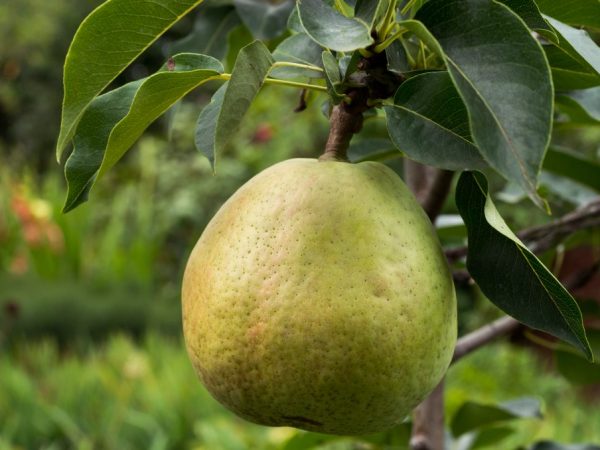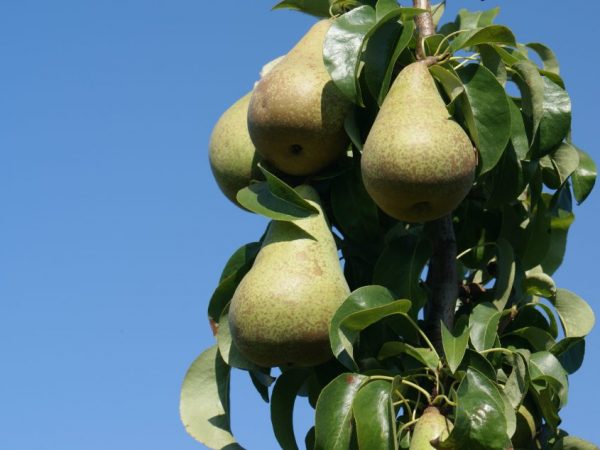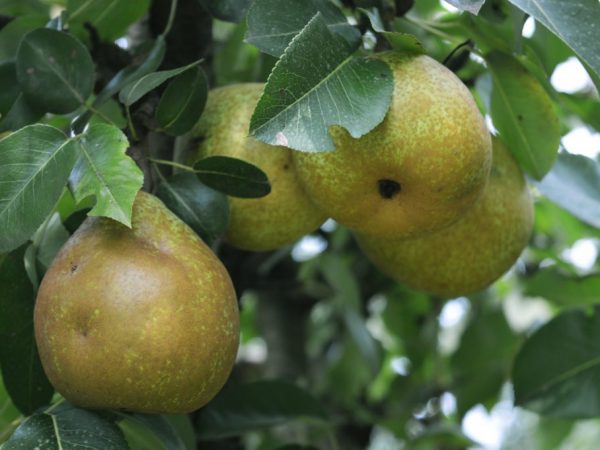Best Columnar Pear
Every farmer wants to get a bountiful harvest, but the size of the plot does not always allow setting up a garden. In this case, it is better to give preference to dwarf varieties. What is the best columnar pear? Let's take a look at the best hybrids that can be planted in spring without any problems.

Best Columnar Pear
View reference
Small, neat trees appeared not so long ago on the Russian market. Due to their attractive appearance, seedlings are often used in landscape design. But the varieties are best used in the design of gardens.
Columnar pears are a popular dwarf fruit that grows no more than two meters in height. The plant has a main trunk and short processes on which the fruits are located. As such, the tree has no branches, so the hybrid does not need to be formed. In addition, it is not afraid of cold weather and undemanding to the ground.
The shape of the crown is very convenient when harvesting, since the fruits are located at the very trunk, which makes it possible to do without fruit collectors and other garden equipment.
But the most important advantage of the dwarf is its early maturity. The crop begins to produce crops in the third year after planting in a permanent place of development. For 15 years, fertility is stable (from 3 to 8 kg), then a gradual decrease in the intensity of recoil begins.
Columnar pears are summer, autumn and winter, in addition to this, there is a regional reference. If you provide the plant with the right care, then even beginners can get a stable harvest without any problems. The weight of large and juicy fruits ranges from 150 to 300 grams.
Summer varieties
The fruit trees of the summer variety bear fruit exclusively in the warm season. Pears are harvested from late July to mid-August. If you wait a little with the collection, then the fruits begin to deteriorate and lose their taste characteristics.
Carmen
A chic variety that will appeal to connoisseurs of quality fruits. A special feature of the tree is huge pears, reaching 300 grams. From above, they are covered with a burgundy peel, which gives the fruit an appetizing appearance.
The Carmen variety is one of the most popular plants among Russian farmers. This low-maintenance seedling is ideal for setting up gardens, both on an industrial scale and in private plots. It grows and develops without problems with dense plantings, has strong immunity.
Decor
If you are looking for late summer varieties of columnar pears, then we advise you to pay attention to an amazing plant. An early culture will delight the gardener for 2 years after planting in a permanent place of growth. An active harvest takes place at the end of August. Saplings and adult specimens are not afraid of winter cold and have good resistance to common diseases.
The tree with the name Decora does not have such beautiful fruits as Carmen's, but they are in no way inferior in taste.Large (average 300 gr.), Covered with a golden skin with a red blush. The juicy pulp has a pleasant sourness and a rich rose aroma.
Sweet beauty
A popular dwarf culture, which ripens in July-August. An early plant is undemanding to care, is not afraid of frost and common ailments. A bountiful harvest can be removed in the third year after planting in the spring in a permanent place of growth.

The variety is distinguished by large fruits.
Columnar pear Sweet beauty has large fruits reaching 250 grams. The elongated shape looks like a huge light bulb. Juicy pulp with a rich aroma is covered with a greenish-yellow skin.
White-red early
An interesting and unpretentious tree will occupy only forty centimeters on the site. A compact culture will begin to bear fruit 2 years after planting in a permanent place. The plant prefers to grow in the sun, which has a positive effect on resistance to many diseases. According to the description, it can withstand severe frosts and is suitable for the Moscow region.
The white-red early pear is considered the most elegant variety. Elongated fruits are covered with a yellow-ruddy skin. Delicate, sweet pulp has a specific aroma and wine flavor that is in no way inferior to the popular variety of Decor.
D 322
A hybrid that ripens in August. The plant belongs to self-fertile modifications, therefore it does not require the presence of pollinators nearby. An unpretentious culture is not afraid of frost and has an average resistance to diseases. The yield period begins 2 years after planting.
Sort G 322 tastes like the popular Decora pear. Oily, juicy pulp with pleasant sourness and rich aroma. The fruits are shaped like a huge light bulb covered with a golden-green skin with a blush. The weight of each specimen ranges from 150 to 250 grams.
Autumn varieties
Column-shaped pears of medium ripening periods combine high productivity and excellent keeping quality. Saplings, undemanding to care, develop on any soil and are not afraid of the cold.
Sapphire
Ripens by the first days of September. In the period of fruiting begins 4 years after planting in a permanent place of growth. He tolerates scab, but in severe frosts, the tree should be protected. Reproduction, as in all columnar species, occurs exclusively by seedlings, the layers do not retain their maternal properties.
The Sapphire variety can be recognized by elongated pears covered with green skin with tiny rusty spots. The pulp is very tender and juicy, has a rich aroma. Fruits are large (from 200 g), excellent keeping quality under minimal storage conditions.
Honey
Popular domestic culture, developed in the early 60s of the last century. Ripening occurs in mid-September. Due to its immunity to diseases and frost resistance, the tree is recommended for the Moscow region and other regions of the Central strip.
Column-shaped honey pear tastes like the popular type of Sapphire. Delicate, slightly sour flesh is covered with a green skin with a blush. The fruits are large (from 300 to 500 g), have an elongated shape and a bumpy surface. Increased keeping quality, products of universal application.
D 333
Ripening occurs in early September. Compact trees do not take up much space on the site and are undemanding to maintenance. They enter the period of active fruiting early (in the second year after planting), the harvest is stable and long-lasting.
Outwardly, the hybrid G 333 resembles the popular varieties of the columnar pear Sapphire and Honey. The same green glossy skin, which is covered with a juicy blush. The pulp has a specific rich aroma with subtle floral notes.
Pavlovskaya
An interesting tree, which ripens in early autumn - early September. They enter the fruiting period in the third year after planting in a permanent place of growth.In one season, 8 kg of products can be removed from the plant. It is not afraid of frost and has increased resistance to diseases and parasites.
Pavlovskaya columnar pear in taste characteristics resembles the varieties Medovaya and Saphira. Delicate, juicy pulp with a rich floral aroma. One of the important advantages of the fruit is its excellent keeping quality.
Knight Werth

The fruits are versatile in use
A small tree that does not need to be shaped. The Dutch variety often delights gardeners and pleases with a bountiful harvest 3 years after rooting. In autumn, the plant is not afraid of frost and disease, it is suitable for the Moscow region.
Night Werth is a unique variety that has no analogues in its characteristics. The pulp is rich, with a recognizable honey-lemon flavor. Large fruits are covered with a green skin with a bright blush. They are consumed both fresh and processed into confitures and jams.
Winter varieties
If you need sweet fruits until spring, then we recommend planting late dwarf seedlings. In terms of taste, they are not inferior to those collected in summer and autumn, but they are stored much longer.
Bogatyr
Bogatyr is one of the most popular varieties that ripens by October. It enters into the period of abundant productivity in the same way as other varieties of compact trees. It is not afraid of frost and has improved resistance to ailments.
The fruits are large (300 gr), have an elongated shape. Fragrant, juicy pulp with a honey flavor, covered with a golden skin. Excellent product characteristics are evident during transportation and storage.
Dalikor
Winter plant of French selection, which ripens in early October. Like all imported hybrids, it is not afraid of common diseases and is resistant to cold. The yield period begins 3 years after rooting.
The Dalikor variety is a giant (up to 500 g) fruit, covered with a yellowish skin with pink cheeks. The fruits do not lose their commercial characteristics during transportation and storage. Excellent taste of the pulp:
- creamy texture;
- without granulation;
- sweet, honey flavor;
- rich aroma.
Sunreli
With minimal care in the spring, it will delight you with the first fruits three years after rooting. Harvesting occurs in October and early November. A compact plant does not take up much space on the site. Not afraid of frost and disease resistant. Growing a columnar pear will not be a problem even for beginners.
Fruit weight ranges from 150 to 250 grams. Each piece resembles a balloon in shape. Juicy, sweet pulp is covered with a green skin with a rusty speck.
If you choose the right variety for your site, then growing and caring for columnar pears will not be a hassle. Unpretentious trees will delight you with a bountiful harvest with minimal physical and material investments. We have sorted out the best varieties of the popular fruit crop with a detailed description.


